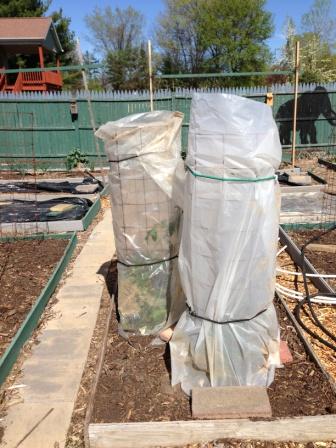Early Tomatoes - A Dream Realized

When I was a novice gardener I thought serious bragging rights were due to any tomato grower that was harvesting ripe tomatoes by July 4th. While that's an admirable accomplishment even by today’s standards, the bar has risen by a full month. Follow my advice and you too can be feasting on ripe tomatoes by early June. (And without a greenhouse!). Personal disclosure - my record is June 6th.
Note: Most of the techniques enumerated here were stolen from that venerable tome "Crockett’s Victory Garden". I’ve fiddled with a few details and added some additional information gleaned from my 10 years of experience practicing this rare form of gardening insanity.
Before enumerating the necessary steps for rising into the upper echelons of tomato culture stardom, let me mention that you're going to have some large plants on your hands by May 1st when the tomatoes go into the ground. I start with six seedlings, and as time goes on I give away all but two of the healthiest plants.
So here's the precise pathway to horticultural heaven:
- Start Early Girls in the first 2 weeks of January (yes, January)
- Keep them under florescent lights 18 hours a day (keep the lights very close to the plants)
- Transplant them into successively larger containers every 4 weeks or so. Plant them deeper each time.
- Bring them outside into the sunshine starting when the days are at least in the 60's (April or so). Avoid windy days. By mid April flowers will begin to form on the plants. You’re well on your way to the Promised Land.
- In early April cover the garden soil where you’ll be planting your tomatoes with clear plastic (not black plastic which does not warm up the soil nearly as much as clear plastic)
- On May 1st (or so) plant them in the spot that you’ve been warming with the clear plastic. As always, plant the tomatoes deeper so that more of the stem is below the soil line. It’s very likely that small to medium sized tomatoes will have formed by this point (in fact, if they haven’t, you’re running behind schedule).
- Place a cage made from concrete reinforcing wire over the tomatoes and then wrap clear plastic around the cage. I use bungee cords to secure the plastic around the cages. You must anchor the cages to the ground or they will tip over in high winds.
The month of May can be a time of wildly fluctuating weather. In some locales the temperature may dip down into the 30’s at night. Since you’ve no doubt taken my advice and have limited yourself to 2 plants, the extreme steps outlined here shouldn’t be too onerous.
I’ve used two techniques to keeping my precious tomatoes warm on cold nights:
- A small lamp with a 25 watt bulb (this has the additional benefit of preventing your tomatoes from having early blight nightmares).
- Bottles filled with hot water (or used crankcase oil).
Technique number 1 requires far less effort once you’ve set up the electrical connections.
There will be days, especially towards the end of May, when you will want to take the plastic wrap off the cages to allow the tomato plants full exposure to the sun and prevent overheating of their enclosures. Using bungee cords to hold the plastic in place makes these maneuvers fairly easy to perform.
As you can easily see, no small amount of labor and love go into this endeavor, but did Edison invent the light bulb overnight? By containing your experiment to just 2 plants, you’ll somewhat limit your effort and still provide enough ripe tomatoes in June and July to be the envy of the entire neighborhood and your Facebook universe.
Some additional notes:
DO NOT heavily fertilize the plants! They will put all their energy into foliage production and you'll be lucky to get a single ripe tomato by August. A little half strength liquid fertilizer when they first go into the ground should be plenty.
As for tomato cages, the store-bought variety, at least the ones I've seen, won't do the trick (too small). I suggest building cages out of concrete reinforcing wire. Handling the reinforcing wire and creating the cages will be challenging (actually very challenging). The cages should be about 25" in diameter. Wear heavy work gloves when working with the wire unless you're aiming for a prolonged trip to the DL.
So that's it. My advice is to keep your little experiment a secret from the neighbors, and then surprise them with some of the fruits of your labor if and when you succeed. As their awe and admiration wash over you in tidal waves of red envy, you'll be forced to admit that it was all worth it. After all, isn't that the very core of human striving - to demonstrate your horticultural superiority over mere mortals who are inexplicably willing to accept August tomatoes as the immutable course of intergalactic destiny?
Author:Paul Zimmermann
